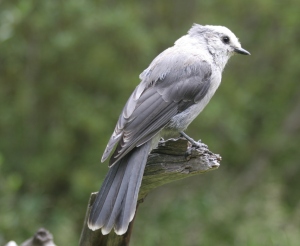If you want to get to know the Gray Jay, plan a picnic in one of Summit County’s high forests. Find a suitable spot, open your lunch bag, sit back and relax. You won’t have to wait long, since they don’t call this bird the ‘Camp Robber’ for nothing. In fact, if you’re willing to share, bold Gray Jays will perch on your hand to snatch most anything offered. Little of this confiscated food is eaten on the spot, though. The jay will grab a morsel and immediately fly back into the trees. It’s not that they’re antisocial; these year-round residents squirrel away lots of groceries to get them through the mountain winter.
Enjoyed both by summer visitors and winter skiers, Gray Jays are found in Summit County throughout the year. Turning their noses up at wimpy migrants, these birds are unmoved by snow and ice, living off their summer caches until spring and picnickers return. Food to be stored is coated with the bird’s sticky saliva, and then hidden in bark crevices or stuck to high tree branches. Displaying incredible memory, Gray Jays return to these innumerable hiding places throughout the bleak winter, surviving on the well-preserved food. One of the jay’s cousins, and another year-round mountain resident, the Clark’s Nutcracker, similarly caches thousands of pine nuts and seeds. Most of these seeds are buried, and although the nutcracker remembers the location of most of these, those that are forgotten are an important part of forest regeneration.
The Gray Jay and his Relatives
Gray Jays belong to the Corvids, a family that includes crows, ravens, other jays and magpies, as well as the Clark’s Nutcracker, a total of 20 species in North America. Corvids are omnivorous, and although they forage for seeds and insects, Gray Jays also prey on other birds’ eggs and nestlings. One was even seen nabbing an in-flight warbler.
With their large round heads and small bills, Gray Jays look more like overgrown chickadees than other American jays, and in fact belong to a different Corvid group, the only American representative of Old World jays. Lifelong monogamous partners, pairs of Gray Jays share much of family responsibility, and both continue to feed fledglings long after they have left the nest. When first hatched, young are helpless and featherless, hence the familiar phrase, naked as a jay. Unlike many other birds, Gray Jays nest just once each year, and they do it surprisingly early, in March or April, when snow is still deep. This early start easily leaves time for another brood, but experts think the jays’ priority is warehousing food for the coming winter.
Gray Jays also differ from our other birds in a unique sibling rivalry. After the typical three or four young leave the nest, they remain together initially as a family, but a month later, begin fighting until one dominant nestling has driven the others away. The reasons for this behavior are unclear, but it must contribute toward overall survival of the species, rather than diminish it, as one might first think. Even though young jays begin storing food soon out of the nest, their early efforts may be ineffective. If so, they would need to supplement their own caches with parental stores, and eliminating competition would improve the chances of the remaining dominant bird. This is supported by studies that show 80% of displaced nestlings die within the first year.
Originally called the Canada Jay (the scientific name is Perisoreus Canadensis), the Gray Jay was also known as ‘Whiskey Jack.’ This unusual name has nothing to do with liquor. Instead, ‘Whiskey Jack’ is an Anglicized version of ‘wiskedjak’, a creature from Algonquian mythology known, appropriately, for his mischievous pranks. So, all is not lost. These camp robbers might steal your sandwich and chips, but they won’t touch your Jack Daniels.
(This article originally appeared in the Summit Daily News, Frisco, Colorado, on July 21, 2012. Text and Photographs copyright Bob Bowers)


